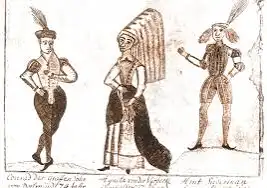
Dortmund is the third-largest city in North Rhine-Westphalia, after Cologne and Düsseldorf, and the ninth-largest city in Germany. With a population of 612,065 inhabitants, it is the largest city of the Ruhr as well as the largest city of Westphalia. It lies on the Emscher and Ruhr rivers in the Rhine-Ruhr Metropolitan Region, the second biggest metropolitan region by GDP in the European Union, and is considered the administrative, commercial, and cultural centre of the eastern Ruhr. Dortmund is the second-largest city in the Low German dialect area, after Hamburg.

Reinhard Mohn was a German billionaire businessman and philanthropist. Under his leadership, Bertelsmann, once a medium-sized printing and publishing house, established in 1835, developed into a global media conglomerate. In 1977, he founded the non-profit Bertelsmann Stiftung, which is today one of the largest foundations in Germany, with worldwide reach.

Bunte is a German-language weekly celebrity gossip magazine published by Hubert Burda Media. The first edition was published in 1948 under the name Das Ufer. Under the leadership of Hubert Burda, Bunte developed into a modern popular magazine. In 2014, Bunte was the 11th most popular media brand in Germany, with 10.57 million monthly users. After Patricia Riekel stepped down, Robert Pölzer took over as Editor-in-Chief in July 2016.

Michael Zorc is a German former footballer who played as a central midfielder.

Marcel Halstenberg is a German professional footballer who plays for 2. Bundesliga club Hannover 96 and the Germany national team. In addition to playing to the left-back position, he plays in the centre-back position.

Altes Stadthaus in Dortmund, North Rhine-Westphalia, Germany, is an office block which was built in 1899, and was designed by "master builder" Friedrich Kullrich. It was built in the Renaissance Revival architecture (Neo-Renaissance) style. After the office block was severely damaged in World War II, it was rebuilt in a simplified form.

Friedrich Harkort, known as the "Father of the Ruhr," was an early prominent German industrialist and pioneer of industrial development in the Ruhr region.
The Sauerland Net is a group of railway services in the western Sauerland and the eastern Ruhr of the German state of North Rhine-Westphalia and consists of four Regionalbahn services, RB 43 (Dortmund–Dorsten), RB 52 (Dortmund–Hagen–Lüdenscheid), RB 53 (Dortmund–Schwerte–Iserlohn) and RB 54 (Unna–Fröndenberg–Menden–Neuenrade), and the Regional-Express service RE 57. The RB 43 also carries the brand name of the Emschertal-Bahn, the RB 52 is called the Volmetal-Bahn, the RB 53 is called the Ardey-Bahn, the RB 54 is called the Hönnetal-Bahn and the RE 57 is called the Dortmund Sauerland-Express. In December 2004, DB Regio NRW took over or retained operations of these services. Previously the RB 53, RB 54 and RE 57 had been operated by DB Regio NRW and RB 52 had been operated by the Dortmund-Märkische Eisenbahn (DME).

Nordmarkt is a borough in the Stadtbezirk Innenstadt-Nord in Dortmund, Germany.

During the 2015–2016 celebrations of New Year's Eve in Germany, approximately 1,200 women were reported to have been sexually assaulted, especially in the city of Cologne. In many of the incidents, while these women were in public spaces, they were surrounded and assaulted by large groups of men who were identified by officials as Arab or North African men. The Federal Criminal Police Office confirmed in July 2016 that 1,200 women had been sexually assaulted on that night.

Kreuzviertel is a neighbourhood of Dortmund, Germany and it has about 15,885 inhabitants (2015). Along with the Nordstadt in the north and the Kaiserviertel in the east, it is part of Dortmund's dense inner city districts.

Aplerbeck is a borough (Stadtbezirk) of the city of Dortmund in the Ruhr district of North Rhine-Westphalia, Germany. Since 1929, it has been a suburb of Dortmund, located in the city's south-east. The river Emscher, a tributary of the Ruhr, crosses Aplerbeck.

The Linienstraße is a street in Dortmund, Germany, known for prostitution. The street is located north of the city's main railway station Dortmund Hauptbahnhof in the Stadtbezirk Innenstadt-Nord district. There have been brothels on Linienstraße since the beginning of the 20th century. Under the "Sperrbezirk" regulations, prostitution in central Dortmund is only permitted in Linienstraße.

Dortmund I is an electoral constituency represented in the Bundestag. It elects one member via first-past-the-post voting. Under the current constituency numbering system, it is designated as constituency 141. It is located in the Ruhr region of North Rhine-Westphalia, comprising the western part of the city of Dortmund.
Ernst Huhn (1894–1964) was a German architect who first rebuilt and later designed cinemas, theatres and inns, including the Schauspielhaus Bad Godesberg, Germany's first new theatre after the Second World War
Ousman Sey was a 45-year-old man from Gambia living in the Nordstadt district of Dortmund in Germany. On 7 July 2012, Ousman Sey began to feel pains in his chest at his house in Dortmund, Germany. He called the emergency services and they told him he did not need to go to hospital. Becoming agitated, he broke a window in his apartment, causing a neighbour to call the police. When the police arrived, he complained about his chest pains; paramedics again said he did not need to go to hospital. He was then arrested and detained. He later died in police custody.
Rolf Fritz was a German art historian. His research focused on German art from the Middle Ages to the 19th century, especially on the art and cultural history of Westphalia, as well as on various genres of arts and crafts.

Agnes von der Vierbecke, also Agneta is the only medieval woman from Holzwickede and Dortmund to be documented in the historical record. Agnes is known for her participation in the feud between the Dortmunders and Count Dietrich von Dinslaken, a brother of Count von der Mark.















